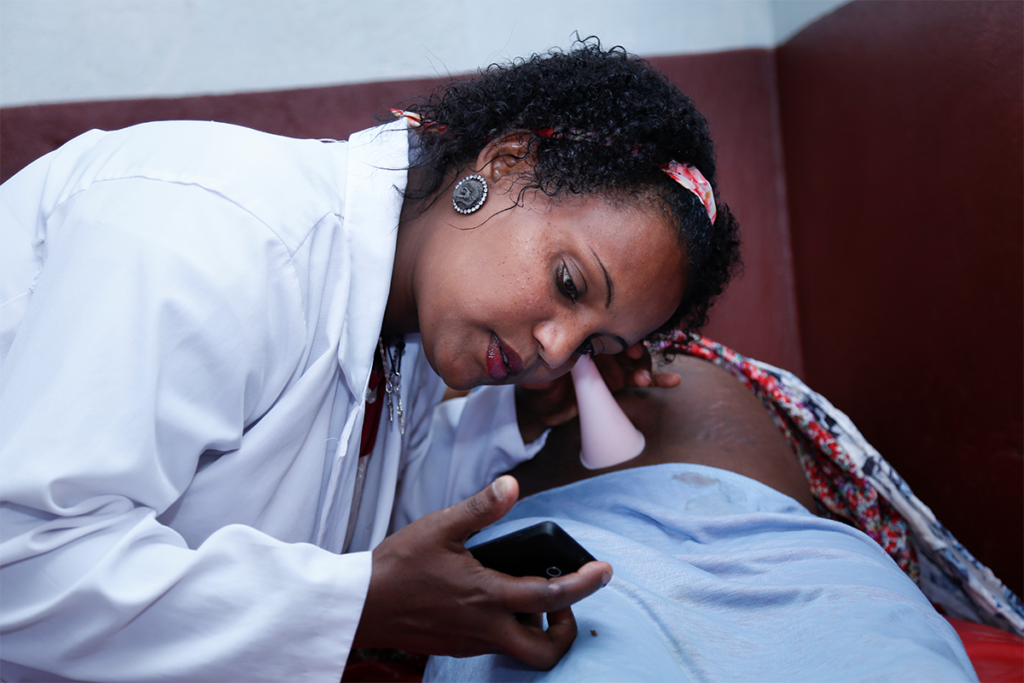By: Emily Keyes (FHI 360), Molly Canty (Dimagi) & Ali Flaming (Dimagi)
This blog post was originally released by Dimagi. Reposted with permission.
April 1st, 2018 marked seven months since the launch of mLabour — a comprehensive labour management tool built on CommCare — in three private health facilities in Tanzania (check out Part I of the mLabour Innovation Blog Series to learn more about the project).
The midline results are now in, and we’re excited to share that the data indicates an overall improvement in adherence to clinical protocols, as well as an exceptionally high uptake of the tool. Furthermore, patients have shared encouraging thoughts on how mLabour impacted their care.
Clinical adherence
Our primary indicator of success for mLabour is the change in clinical adherence between baseline and endline results. To evaluate this metric, we assigned patients an adherence score based on a composite of patient-level data related to clinical protocols, such as:
- Was the fetal heart rate recorded at the time of admission?
- Was a vaginal exam conducted every four hours?
- Was descent of the baby’s head examined and recorded every four hours?
- Was oxytocin administrated for the prevention of postpartum hemorrhages?
We compared these baseline indicators — all gathered via paper medical records — against midline indicators captured electronically through the mLabour application.
The results indicate mLabour improved clinical adherence to the labor-management protocol by 18 percent within the first three months of use.
However, there remains room for improvement. Our analysis indicated that the lowest coverage of assessments tracked through the mLabour application included assessments that are carried out every 30-minutes such as: recording a woman’s pulse, fetal heart rate and contractions.
We also looked at changes in other aspects of clinical care, like screening for danger signs at admission. The chart below shows how results changed between baseline and midline coverage of key screenings for risks such as bleeding, eclampsia and infection.
In most cases, coverage at midline — when clinics were using mLabour — was nearly universal.

Uptake and usability
Since launch, uptake of the mLabour tool in the three implementing facilities has been very high. Usage began at 100 percent of all eligible deliveries and continued to hover at nearly 100 percent in the following months.
In fact, over the entire period, 93 percent of all eligible deliveries were tracked by mLabour.
A number of factors affect usage rates, but we believe mLabour’s uptake has been high due to a sense of ownership fostered within the health facilities that are implementing the tool. Midwives in these clinics were an integral part of the application design process, and are empowered to both share feedback and take ownership of the mLabour tool.
Additionally, ensuring an enjoyable, efficient user experience is key. At our midline evaluation, we conducted a survey on usability, which asked midwives to rate their experience in categories like impact on quality of work/life, perceived usefulness of the tool and ease of use. Respondents overwhelmingly rated mLabour as a positive addition to their labor wards, and to their service delivery model as a whole. Similarly, users indicated mLabour helped them more easily and consistently follow labour management protocols.
Patient satisfaction
At midline evaluation our team also completed 15 in-depth qualitative interviews with women who had recently delivered babies.
These interviews asked specifically about the women’s perception of tablet usage, as well as their overall satisfaction with patient-provider interactions. The feedback was very encouraging, as overall satisfaction levels were very high. Importantly, most women with whom we spoke felt tablets were a good addition to their clinical care, indicating they felt it “modernized” the patient experience.
Next steps
The final part of our midline analysis was an evaluation of mLabour’s readiness to be scaled to additional health facilities. Given the success of the program to date, both our team and the local partners, APHFTA and PRINMAT, agreed mLabour is ready for further implementations and plans were created to scale the application to additional facilities. Over the next few months APHFTA and PRINMAT will be training six new clinics to use mLabour.
Stay tuned for an upcoming post on how we used evaluation results and a stakeholder engagement process to determine whether mLabour was ready to scale!
Photo caption: Use of a Safe Delivery App in Ethiopia
Photo credit: © 2016 Mulugeta Wolde for Maternity Foundation, Courtesy of Photoshare



